Abstract
References
- Kayal R. A. (2016). Distortion of digital panoramic radiographs used for implant site assessment. Journal of orthodontic science, 5(4), 117–120.
- Rondon, R. H., Pereira, Y. C., & do Nascimento, G. C. (2014). Common positioning errors in panoramic radiography: A review. Imaging science in dentistry, 44(1), 1–6.
- Rushton, V. E., & Horner, K. (1996). The use of panoramic radiology in dental practice. Journal of dentistry, 24(3), 185–201.
- Ladeira, D. B., Cruz, A. D., Almeida, S. M., & Bóscolo, F. N. (2012). Influence of the intergonial distance on image distortion in panoramic radiographs. Dento maxillo facial radiology, 41(5), 417–421.
- Legg, L. (2005). Panoramic radiography. Radiologic Technology, 76(3), 197+.
Abstract
Aim The aim of this study was to evaluate the distortion rates of the mandible on panoramic radiographs and to prepare bone grafts close to the actual values with a preliminary study. In patients with mandibular defects due to any cause, the dimensions of the bone graft used to repair the defect are compatible with the original dimensions of the defect, allowing a better contour. However, bone grafts used in clinical applications are prepared empirically. As a result, functional problems may occur during reconstruction. The aim of this study was to determine the appropriate bone graft to use in patients undergoing jaw reconstruction.
Material and method Two groups were prepared in the study. In the first group one cm radiopaque wires were wrapped over the mandibles. In the other group, points of random length were marked with wires and panoramic radiographs were taken.
Results As a result of the statistical study, these deviations in each region of the mandible were found to be highly significant according to the “Student T” test (p value 0.001 for each region). Distortion rate is different in each region..
Conclusion In cases where jaw reconstruction is being considered, it may be helpful to calculate the appropriate dimensions for the healthy state of the jaw by determining the excision margins on panoramic radiographs. Preoperative determination of the size of the defects is important for both the surgeon and the patient in planning the operation and achieving optimal results. In this way, prolonged surgery can be avoided and a near-optimal result can be achieved in the patient’s jaw.
References
- Kayal R. A. (2016). Distortion of digital panoramic radiographs used for implant site assessment. Journal of orthodontic science, 5(4), 117–120.
- Rondon, R. H., Pereira, Y. C., & do Nascimento, G. C. (2014). Common positioning errors in panoramic radiography: A review. Imaging science in dentistry, 44(1), 1–6.
- Rushton, V. E., & Horner, K. (1996). The use of panoramic radiology in dental practice. Journal of dentistry, 24(3), 185–201.
- Ladeira, D. B., Cruz, A. D., Almeida, S. M., & Bóscolo, F. N. (2012). Influence of the intergonial distance on image distortion in panoramic radiographs. Dento maxillo facial radiology, 41(5), 417–421.
- Legg, L. (2005). Panoramic radiography. Radiologic Technology, 76(3), 197+.
Details
| Primary Language | English |
|---|---|
| Subjects | Oral and Maxillofacial Radiology |
| Journal Section | Research Articles |
| Authors | |
| Publication Date | August 31, 2023 |
| Submission Date | July 27, 2023 |
| Published in Issue | Year 2023 Volume: 1 Issue: 2 |


